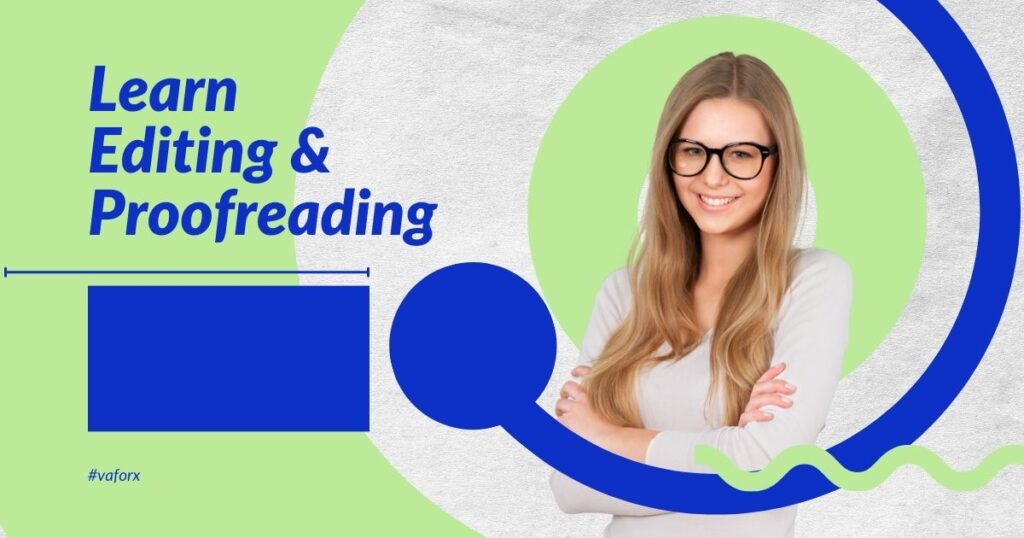5 Tips for Proofreading with a Fresh Mind: Writing an Error-Free Article
Learn valuable tips for effective proofreading, including reading for context, focusing on spelling and grammar, saving a new copy, and using AI tools. Enhance your proofreading skills now!
10-second summary- Proofreading is the process of checking a written document for errors in grammar, spelling, punctuation, and formatting.
- It is an essential skill for anyone who writes, as even a single error can make a document look unprofessional and damage its credibility.
- The best way to proofread is to read the document carefully, preferably aloud, and pay attention to every word.
- You should also check for consistency in grammar, punctuation, and formatting.
- If you are not sure about a particular rule, consult a dictionary or style guide.
- There are also a number of AI tools available that can help with proofreading. However, it is important to remember that these tools are not perfect and should not be used as a substitute for human proofreading.
Proofreading can be a complex task that involves more than just fixing spelling mistakes. In a video by Erin Booth, viewers are given a practice task to proofread a document containing 16 spelling mistakes and 3 grammatical errors. The video provides 9 helpful tips for effective proofreading including reading through the document for context, focusing on spelling, grammar, punctuation, and format, saving a new copy of the document, and utilizing AI tools for assistance. Proofreading may seem simple, but it requires a fresh mind, attention to detail, and an understanding of the document’s purpose and tone. So, if you’re looking to enhance your proofreading skills, this video is a valuable resource to refine your abilities as a virtual assistant.
Understanding the Importance of Proofreading
Proofreading as a valuable skill
Proofreading is an essential skill that can greatly impact the effectiveness and credibility of any written document. Whether you’re writing a simple email, an important report, or even a novel, proofreading ensures that your message is clear, concise, and error-free. By carefully reviewing and correcting spelling, grammar, punctuation, and formatting mistakes, you can enhance the overall quality of your writing. Proofreading is not only about catching mistakes, but it also helps to refine your work, improve your language skills, and showcase your attention to detail.
Different forms and shapes of proofreading
Proofreading takes on various forms and shapes depending on the type of document being reviewed and the purpose it serves. For example, proofreading a business report requires a different set of skills than proofreading a creative piece of writing. The goal of proofreading is not only to correct errors but also to ensure that the document achieves its intended purpose. Therefore, it is crucial to consider the target audience, context, and desired tone of the document when proofreading.
Preparing for Proofreading
Save a new copy of the document
Before you begin proofreading, it is important to create a new copy of the document. This allows you to have a clean slate to work with, ensuring that any changes or edits you make during the proofreading process do not affect the original document. Saving a new copy also provides a backup in case any mistakes are made or if you need to refer back to the original version.
Check the purpose and tone of the document
Understanding the purpose and tone of the document is essential for effective proofreading. Ask yourself what the document aims to achieve and who the intended audience is. Is it a formal or informal piece? Is the tone persuasive, informative, or entertaining? By considering these factors, you can tailor your proofreading to ensure that the document aligns with its intended purpose and effectively communicates with the audience.

Read through the document for context
Before diving into the details of proofreading, it is essential to read through the entire document to gain a comprehensive understanding of its content and context. This allows you to familiarize yourself with the overall flow, structure, and main ideas presented in the document. By having a clear understanding of the content, you will be better equipped to identify any inconsistencies, errors, or areas that need improvement during the proofreading process.
Proofreading with a Fresh Mind
Benefits of proofreading with a fresh mind
Proofreading requires focus and attention to detail, which can be challenging if you approach it with a tired or cluttered mind. By proofreading with a fresh mind, you enhance your ability to spot errors and inconsistencies more effectively. A fresh mind allows you to approach the document with a renewed perspective, enabling you to identify areas where improvements can be made in terms of clarity, coherence, and overall quality.
Ways to achieve a fresh mind
To achieve a fresh mind for proofreading, it is essential to take breaks and allow yourself time away from the document. Engage in activities such as going for a walk, listening to music, or practicing mindfulness exercises to clear your mind and reset your focus. It is also helpful to proofread in a quiet and calm environment, free from distractions and interruptions.
Clearing distractions
When proofreading, it is important to eliminate any distractions that may hinder your concentration. Find a quiet space where you can focus solely on the document at hand. Turn off notifications on your phone or computer, close any unnecessary tabs or applications, and let others know that you need some uninterrupted time. By proactively clearing distractions, you give yourself the best chance to thoroughly analyze the document and catch any errors or inconsistencies.
Key Focus Areas for Proofreading

Spelling
One of the most common types of errors found in written documents is spelling mistakes. Spelling errors can negatively impact the credibility and professionalism of your writing. When proofreading, pay close attention to every word and ensure that it is spelled correctly. Use a reliable dictionary or spell-checking software to verify any words you are unsure about.
Grammar
Correct grammar is essential for clear and effective communication. Poor grammar can lead to confusion and misinterpretation of your message. When proofreading, review each sentence and analyze its grammatical structure. Pay attention to subject-verb agreement, verb tenses, sentence fragments, and run-on sentences. Make necessary corrections to ensure that your writing adheres to proper grammatical rules.
Punctuation
Proper punctuation is crucial for conveying meaning and ensuring that your writing is coherent and easy to read. When proofreading, check for missing or misplaced punctuation marks. Look out for issues such as missing commas, incorrect use of apostrophes, and inconsistency in punctuation style. Pay close attention to punctuation rules specific to the type of document you are proofreading, as certain types of writing may have unique conventions.
Format
In addition to correcting spelling, grammar, and punctuation mistakes, proofreading also involves reviewing the formatting of a document. Ensure consistency in font styles, sizes, and margins throughout the document. Check that headings, subheadings, and bullet points are properly formatted and aligned. Pay attention to any formatting inconsistencies, such as inconsistent indentation or spacing. A well-formatted document not only looks professional but also enhances readability.
Using AI Tools for Proofreading Assistance

Introduction to AI proofreading tools
With advancements in technology, there are now AI tools available to assist with proofreading. These tools utilize artificial intelligence algorithms to automatically detect and correct spelling, grammar, and punctuation errors in written text. AI proofreading tools can help speed up the proofreading process and catch errors that may have been missed by human proofreaders.
Top AI tools for proofreading
There are several AI tools available that can assist with proofreading. Some popular options include Grammarly, ProWritingAid, and Hemingway Editor. These tools can be integrated into various writing platforms or used as standalone applications. They provide suggestions for improvements in spelling, grammar, punctuation, and style, allowing you to enhance the quality of your writing.
Pros and cons of using AI tools
Using AI tools for proofreading has its own set of advantages and disadvantages. One of the main advantages is the speed and efficiency with which these tools can review a document. They can instantly identify errors and provide suggestions for improvement. Additionally, with AI tools, you can gain insights into your writing patterns and learn from the mistakes you make. However, it is important to note that AI tools are not foolproof and may not always accurately identify errors or suggest appropriate revisions. It is still necessary to have a human proofreader review the document as well to ensure its accuracy and overall quality.
Common Mistakes to Look Out For
Spelling mistakes
Spelling mistakes can easily slip through the cracks if not thoroughly checked. Look out for commonly misspelled words and pay attention to homophones, where words sound the same but have different spellings and meanings. Proofreading can help catch these spelling errors and ensure that your writing is free from embarrassing mistakes.

Grammatical errors
Grammar plays a vital role in effective communication. Grammatical errors can impede the clarity and understanding of your writing. Look out for subject-verb agreement issues, incorrect verb tenses, incorrect word order, and faulty parallelism. Proofreading allows you to catch and correct these errors, ensuring that your writing is grammatically correct and conveys your intended message accurately.
Punctuation errors
Punctuation errors can lead to confusion and misinterpretation of your writing. Look out for missing or misplaced commas, periods, quotation marks, and other punctuation marks. Pay attention to punctuation rules specific to the type of document you are proofreading, as some writing styles have unique conventions. By meticulously reviewing the punctuation in your writing, you can enhance its clarity and coherence.
Formatting inconsistencies
Inconsistencies in formatting can make your document appear unprofessional and affect its readability. Look out for inconsistencies in font styles, sizes, spacing, and alignment. Check that headings, subheadings, and bullet points are consistently formatted. By ensuring proper formatting, you can create a visually appealing and cohesive document.
Tips and Techniques for Effective Proofreading
Read the document aloud
Reading your document aloud can help you identify errors, awkward sentence structures, and areas that need improvement. When reading silently, it is easy to miss certain mistakes or overlook awkward phrasing. By reading aloud, you engage both your visual and auditory senses, allowing you to catch errors that you might have otherwise missed.
Take breaks between proofreading sessions
Proofreading can be a mentally demanding task. It is important to give yourself regular breaks to prevent fatigue and maintain focus. Taking breaks between proofreading sessions also allows you to approach the document with a fresh perspective each time. By spacing out your proofreading sessions, you can maintain a high level of accuracy and concentration throughout the process.
Use a checklist
Creating a checklist of common errors and areas to look out for can help streamline the proofreading process and ensure that no mistakes are overlooked. Include items such as spelling, grammar, punctuation, formatting, and overall clarity. Use this checklist as a guide while proofreading to keep yourself organized and focused.
Ask for a second pair of eyes
Sometimes, it can be helpful to have someone else review your document for a fresh perspective. Ask a trusted colleague, friend, or family member to proofread your work. Another person’s point of view can bring attention to errors or inconsistencies that you may have missed. By seeking additional proofreading assistance, you can further enhance the quality and accuracy of your writing.
Make use of online resources
In addition to AI proofreading tools, there are various online resources available that can aid in the proofreading process. Style guides, grammar websites, and dictionaries can provide valuable information and explanations to support your proofreading efforts. Utilize these resources to clarify any language-related doubts you may have and to ensure that your writing is error-free.
Best Practices for Proofreading
Maintain consistency throughout the document
Consistency is key when it comes to proofreading. Pay attention to the usage of similar words, phrases, or terms throughout the document. Ensure that there are no inconsistencies in spelling, formatting, or punctuation. By maintaining consistency, you create a polished and professional piece of writing.
Check for clarity and coherence
Proofreading is not just about correcting errors; it is also about improving the overall clarity and coherence of your writing. Review each sentence and paragraph to ensure that they flow smoothly and logically. Look out for any confusing or ambiguous statements and consider rephrasing them to enhance clarity. By consistently reviewing for coherence, you can ensure that your writing effectively communicates your intended message.
Pay attention to word choice and usage
Proofreading allows you to refine your word choice and usage. Look for opportunities to replace vague or repetitive words with more precise and impactful alternatives. Consider the connotations and context of each word to ensure that they accurately convey your intended meaning. By carefully selecting your words, you can elevate the quality and impact of your writing.
Review formatting and layout
Ensure that your document is visually appealing and well-organized by reviewing its formatting and layout. Check that headings, subheadings, and bullet points are properly formatted and aligned. Pay attention to consistent spacing, indentation, and margins. A well-structured and visually appealing document enhances readability and professionalism.
Dealing with Challenges
Overcoming fatigue and writer’s block
Proofreading can be mentally draining, particularly when dealing with lengthy or complex documents. To overcome fatigue, take regular breaks and engage in activities that relax and rejuvenate you. Additionally, when faced with writer’s block, step away from the document and do something unrelated to writing. Engaging in activities that stimulate creativity, such as taking a walk or listening to music, can help overcome writer’s block and allow you to approach the document with a fresh perspective.
Handling complex or technical documents
Proofreading complex or technical documents can be intimidating. It is important to break down the document into smaller sections and tackle them one at a time. Familiarize yourself with the subject matter and specific terminology to ensure that you understand the content and context accurately. If necessary, consult subject matter experts for clarification. By approaching complex documents systematically, you can effectively proofread them and ensure their accuracy.
Managing time constraints
Proofreading can be time-consuming, especially when faced with tight deadlines. To manage time constraints, plan your proofreading sessions in advance and allocate dedicated time for each session. Prioritize the key focus areas such as spelling, grammar, punctuation, and format. If time is limited, focus on the most critical aspects first and make a note of any additional improvements that can be made at a later time. By efficiently managing your time, you can complete your proofreading tasks effectively.
Conclusion
Proofreading is an invaluable skill that can greatly enhance the quality and impact of your writing. By paying attention to key focus areas such as spelling, grammar, punctuation, and format, you can effectively identify and correct errors and inconsistencies. Using AI tools and seeking additional assistance can further support your proofreading efforts. Embracing best practices and overcoming challenges will enable you to consistently produce error-free and high-quality written documents. So, take the time to proofread your work, and witness the positive impact it can have on your writing.



